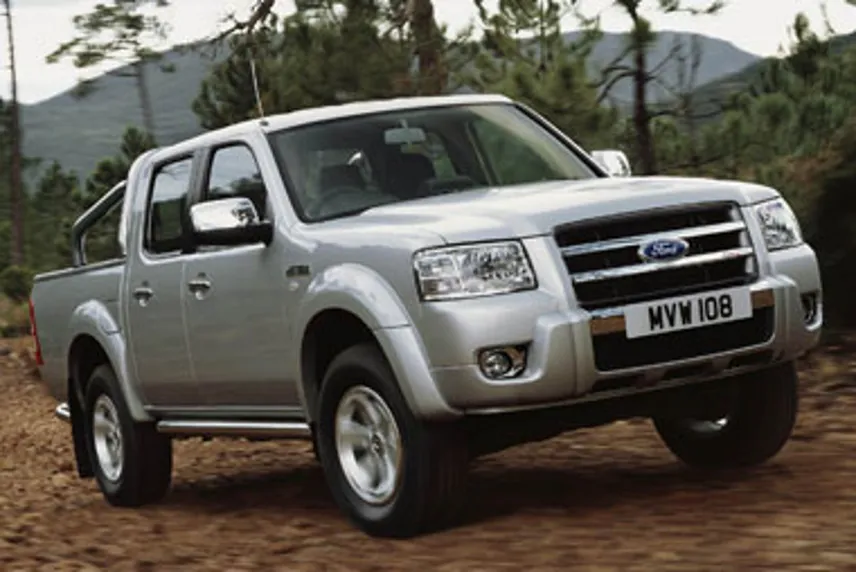Review
WITH the launch of the new Ranger, Ford is the last of the major muscle truck manufacturers to significantly upgrade its offering.
As with the Nissan Navara, Toyota Hilux and Mitsubishi L200, gone is the rattly old-style diesel powerplant, to be replaced by Ford’s more powerful 2.5-litre TDCi common-rail diesel engine, while the outside and inside have been treated to major improvements.
The new Ranger is now likely to appeal to fleets which want a tough vehicle that can also double up as family transport at the weekends, with enough grunt to tow horseboxes and other hobby paraphernalia. Regular, super and double-cab versions will be on offer.
Ford has eschewed the rather wacky looks of the new L200 and has opted instead for a more conventional ‘don’t-mess-with-me’ front end that looks tough and capable.
In the words of Ford CV director Steve Kimber: ‘It is a true off-roader which is both rugged and capable in the harshest of environments and yet stylish and comfortable for the driver who needs it to fit their lifestyle as well as their job.’
The cab has been totally redesigned with better seats and an angular dash which boasts silver and chrome detailing.
A CD player comes as standard, while XLT and Thunder models get a six-CD autochanger.
In the back, the Ranger has a class-leading loadbox and has a one-tonne payload and three-tonne towing capacity. Under the bonnet, the TDCi unit offers 140bhp, up from 107bhp in the old Ranger, while torque increases from 166lb-ft to 243lb-ft. ABS brakes are standard and in addition to dual front airbags, XLT and Thunder models also get side impact bags for the front seats.
Prices range from £11,650 to £17,450 ex-VAT.
Behind the wheel
Mosquitoes, big black ants, unbearable humidity and high temperatures, all in a setting of thick forest along a track barely wide enough for a car, let alone the new Ford Ranger whose wheel I’m wrestling with.
Underfoot, it’s a mix of axle-deep mud-filled ruts and steep rises and dips or, out in the open, hard-baked rock strewn mud. And if that wasn’t enough there is the ever-nearing rumble of thunder, the loud cracks and flashes of lightning and the threat of another torrential downpour.
No, it wasn’t a tropical rainforest – between the rumbles of thunder, planes could be heard on their final approaches to Gatwick airport. Ford had chosen the mosquito-infested woodland of deepest, darkest Sussex to demonstrate the new Ranger’s off-road abilities.
And it chose well.
With its sturdy ladder-frame chassis and all that extra engine torque, off-road performance is excellent.
Better still, armed with a high/low-range transfer gearbox for the four-wheel drive transmission and some new engine-management electronics, the Ranger has a new trick.
Find a fair sized gully, engage ‘low’ and then select first gear. Move off gently down the slope and once rolling, leave the pedals well alone.
Then, once at the bottom, resist any temptation to touch the accelerator pedal because the Ranger continues at its stately speed and crawls its way up and out without stalling, baulking or wheelspin.
This Ranger’s predecessor was considered by some to be too agricultural for serious road use. But a long motorway haul to the off-road course demonstrated the Ranger’s new found car-like refinement and performance.
And that’s thanks to the all-new twin-cam 16-valve, 2.5 litre TDCi Duratorq common-rail diesel engine in place of the old eight-valve lump. Engine power jumps from 107bhp to 140bhp and torque increases from 166lb-ft to an astounding 243lb-ft at only 1,800rpm, which means masses of low-speed pull and no hint of turbo lag.
Inside, our Thunder-specification Ranger included leather seats with a height adjustable leather-trimmed steering wheel and gear knob, twin front and side airbags, air-conditioning and a six-CD player/radio.
Interior plastics are best described as hard and functional. And only the archaic umbrella-type handbrake has been carried over from its predecessor.
The only reminders of the Ranger’s off-road roots are its primitive leaf-sprung rear axle – which means it can’t cope smoothly with, say, expansion joints in the road – and the recirculating ball steering system’s inherent slight vagueness about the straight-ahead position.
Fact file
Power (bhp): 140
Torque (lb-ft): 243
Payload (kg): 990-1,225
Towing capacity (kg): 1,600-3,000
Prices (ex-VAT): £11,650-£17,450
- To view images click on next page.


















